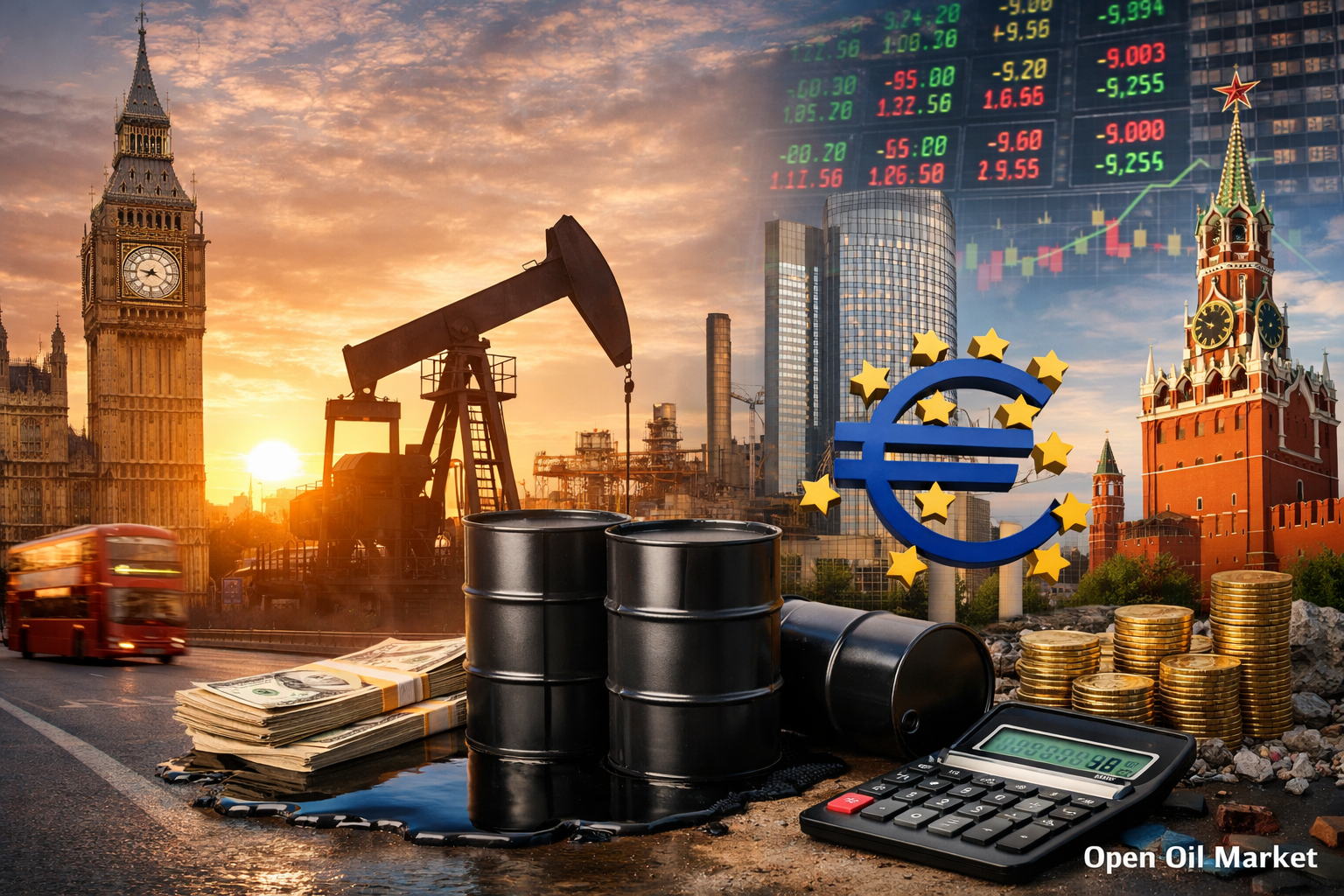
Key Energy Sector News as of November 1, 2025: US-China Trade Truce Inspires Optimism in the Oil Market, Europe Enters Winter with Record Gas Reserves, and Sanction Tensions Surrounding the Russian Energy Sector Continue to Escalate.
As of November 1, 2025, the events unfolding in the fuel and energy sector are taking place against a backdrop of persistent geopolitical tensions, but cautiously positive signals are emerging in the markets. The sanctions standoff between Russia and the West shows no signs of weakening: the US has introduced new restrictions on major Russian oil and gas companies, while the European Union is closing remaining loopholes to circumvent the embargo by implementing the 19th sanctions package, which includes a phased ban on the purchase of Russian LNG. Nevertheless, the global economy received a boost of optimism as on October 30, leaders from the US and China agreed to a trade truce, avoiding a new round of the tariff war. The prospect of easing relations between the two largest economies has improved forecasts for global energy resource demand and supported sentiment in the commodity markets.
Simultaneously, commodity markets are exhibiting relative stability. Oil prices, which had fallen to multi-month lows earlier in the autumn, are holding in a moderate range: Brent is around $64–66 per barrel, while WTI is approximately $60–62. Recent sanction-related news has caused brief spikes in quotes (Brent briefly rose above $66), but overall, the balance between supply and demand remains fragile, leaning towards surplus. The European gas market confidently enters the winter with record fuel reserves: underground gas storage in the EU is over 95% full, providing a buffer ahead of the heating season and bringing exchange prices down to a comfortable ~€30 per MWh (well below the peaks of 2022).
The global energy transition is gaining momentum, with many countries achieving new records in generation from renewable sources, although traditional resources remain essential for the reliability of energy systems. In Russia, after a recent fuel crisis, emergency government measures have stabilized the situation: gasoline and diesel production has recovered, wholesale prices have decreased, and gas stations are adequately supplied with fuel.
Below is an overview of key news and trends in the oil, gas, coal, renewable segments, and the fuel market as of the current date.
Oil Market: Surplus Balance and Risks Amid Trade Truce
Global oil prices remain under pressure from fundamental factors, despite short-term spikes. After falling to multi-month lows in the autumn, Brent quotes have stabilized around ~$60–65 per barrel, which is below early-year levels. The market expects that by the end of 2025, oil supply will exceed demand, driven by several trends:
- Increased Production Amid Slowing Demand. OPEC+ continues to gradually increase output: in October, quotas were raised by approximately 0.14 million barrels per day, with a similar move expected in November. At the same time, major producers outside the cartel (the US, Brazil, and others) have reached record levels of output. Meanwhile, global consumption growth is slowing: the IEA forecasts an increase in demand of only ~0.7 million barrels per day in 2025 (versus over 2 million in 2023). Moderate economic growth, the impact of previous price peaks, and the spread of electric vehicles are limiting fuel consumption increases.
- Geopolitics and Sanction Risks. Heightened sanctions against Russia are restraining parts of its exports—the recent US measures targeting Russian oil companies provoked a spike in Brent prices above $66, showcasing the influence of political factors. The lack of progress in the dialogue between Russia and the US maintains uncertainty. On the other hand, the US-China truce has positively impacted market sentiment, intensifying hopes for stable demand. Consequently, oil prices remain within a narrow range without a clear trend toward growth or decline.
The supply surplus is preventing oil prices from rising significantly. Market participants are acting cautiously, focusing on the surplus, and only serious disruptions could restore high volatility to prices.
Gas Market: Record Reserves in Europe and Flexible Supplies
The situation in the gas market is favorable for consumers, especially in Europe. The continent approaches winter with unprecedented gas reserves: underground gas storage in the EU is over 95% filled. A mild autumn and high imports of liquefied natural gas (LNG) have allowed for such reserves to be accumulated without emergencies, stabilizing wholesale prices at low levels. TTF futures are holding around €30 per MWh—many times lower than the peaks of 2022.
The risk of a repeat of last year's price crisis has significantly decreased, although much depends on the severity of the winter and the availability of LNG. Russia is compensating for the loss of the European market through its eastern direction: flows via the "Power of Siberia" to China have reached record levels, and preparations are underway for the construction of "Power of Siberia 2," with increased shipments of Russian LNG to Asia.
Overall, the global gas sector is entering winter with a solid buffer. Europe’s record reserves and the flexibility of global LNG supplies allow for the expectation of stable prices in the coming months. Unless extreme cold weather or other emergencies occur, the market is expected to remain balanced and comfortable for consumers. Nonetheless, players are continuing to monitor weather patterns and Asian demand for LNG, recognizing that circumstances can change.
Geopolitics: Strengthening Sanctions and Asia's Position
October brought a new wave of pressure on the Russian energy sector amidst the lack of progress in dialogue between Moscow and the West. The US has expanded sanctions against leading Russian oil and gas companies and energy carriers, while the EU has approved the 19th package (including a phased ban on Russian LNG) and a course aimed at a complete rejection of Russian gas by 2026. In response, Russia is strengthening its cooperation with the East and committing to redirect its exports to friendly countries.
India and China, major importers, continue to purchase Russian oil and gas at substantial discounts, remaining key markets for Russia. Despite Western pressure to reduce dependence on Moscow, these countries are not willing to sacrifice their energy security. Simultaneously, they are increasing domestic production and infrastructure (LNG terminals, storage) for the future. The US is attempting to engage Asian giants: under the trade truce, China has agreed to increase imports of American energy supplies. However, for the moment, India and China maintain close ties with Russia, remaining critically important buyers of its energy resources.
Energy Transition: Records in Renewables amid the Role of Traditional Energy
The transition to clean energy is accelerating. In 2025, record capacities of solar and wind power plants are being brought online, and the share of renewables in the global electricity supply has surpassed coal for the first time. Investment in "green" energy has reached all-time highs, supported by government programs. Nevertheless, oil, gas, and coal still constitute the backbone of energy supply—especially for industry and transportation. The stability of energy systems is currently ensured by traditional gas and coal plants, compensating for the intermittency of solar and wind. Governments and companies are increasing investments in energy storage and hydrogen technologies, but achieving carbon neutrality remains a challenge for the coming decades and will require infrastructure modernization.
Coal Market: Demand in Asia and Phasing Out Coal in the West
Contrasting trends are evident in the coal market. In Asia, demand remains high: extreme heat in summer has driven a spike in coal generation and prices (Australian coal quotes reached multi-month highs). Exporters have increased shipments, stabilizing prices in the autumn. At the same time, developed countries are accelerating their coal phase-out: the share of coal generation in the EU has dropped below 10%, with some countries planning to close coal plants within this decade. In the US, cheap gas and the explosive growth of renewables are displacing coal from the energy mix. As a result, global coal prices are significantly lower than they were a year ago, reflecting weakening demand outside Asia.
Russian Fuel Market: Stabilization and Tight Control
After the summer fuel crisis, Russian authorities have taken stringent measures to normalize the domestic market. The export ban on gasoline has been extended (until the end of 2025), and the export of diesel is strictly limited. Refineries are receiving compensation for redirecting fuel to the domestic market, while prices at gas stations are under tight control (without direct freezing). These measures have allowed for the restoration of gasoline and diesel production and supply to normal levels by the end of October. The government aims to get through the winter without disruptions, and in the event of a shortage threat, is prepared to quickly reinstate export restrictions. However, long-term stability requires investments in storage and transportation infrastructure, as well as modernization of refining—temporary measures alone will not resolve the issue.
Forecasts and Prospects: Cautious Optimism Before Winter
By the end of 2025, the energy sector is expected to adapt to new realities. The sanctions standoff has radically altered supply routes: Europe has nearly ceased its imports of Russian gas and sharply reduced oil imports, while Russia has redirected exports eastwards, strengthening ties with Asia. At the same time, fundamental factors are favorable for consumers: oil and gas supply is covering demand (storage is full, production is at high levels, and consumption growth has slowed), leading to prices stabilizing at moderate levels—much lower than the peaks of previous years.
A cautiously optimistic forecast for the winter suggests no significant disruptions. If there are no extreme cold spells or new crises, the oil market should maintain a surplus and low prices, while record gas reserves will prevent gas prices from rising sharply even if consumption increases. For investors and companies in the sector, this situation means more predictable operating conditions, although profitability is now lower than during the commodity boom. Nonetheless, risks remain: escalating conflicts, new sanctions, or technological disasters could disrupt the balance. Moreover, the acceleration of the energy transition will gradually reduce demand for fossil fuels, prompting energy companies to prepare for structural changes.




